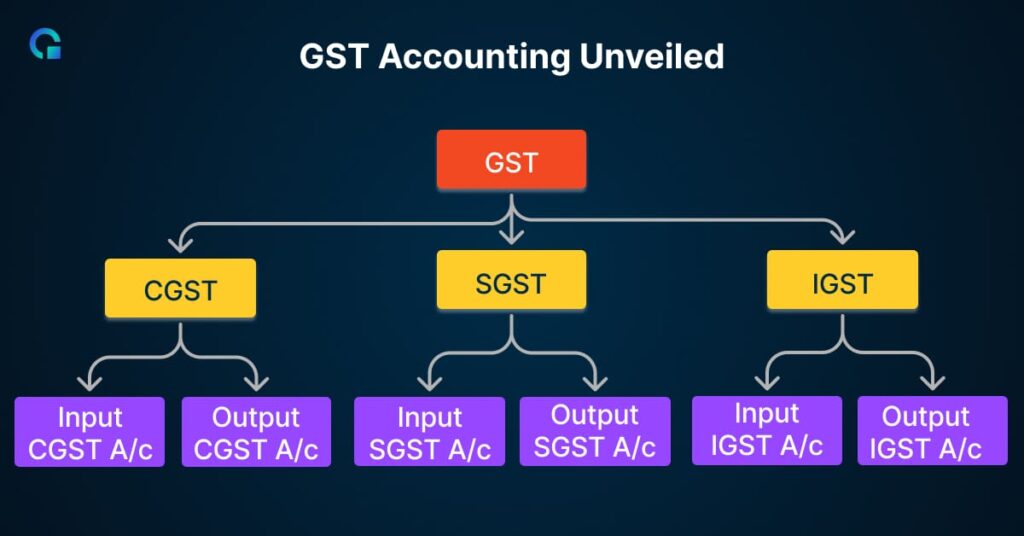Home » GST Accounting Unveiled: An Expert’s Guide with Real-Life, Simple Examples
- TRENDING ARTICLE
GST Accounting Unveiled: An Expert's Guide with Real-Life, Simple Examples

Anurag Mittal

Hey there! If you’re feeling overwhelmed by the complexities of Goods and Services Tax (GST) accounting, you’re not alone. As a GST expert who’s worked with businesses of all sizes, I’ve seen firsthand how confusing it can be. But don’t worry—I’m here to break it down for you in simple, relatable terms, complete with detailed, easy-to-understand examples. Let’s dive in!

Table of Contents
ToggleUnderstanding GST: A Quick Recap
Before we jump into accounting specifics, let’s quickly revisit what GST is all about.
What is GST?
GST is a comprehensive indirect tax levied on the manufacture, sale, and consumption of goods and services across India. It replaced multiple indirect taxes like VAT, service tax, and excise duty, unifying them under a single system.
Key Features:
- Destination-Based Tax: GST is charged where the goods or services are consumed, not where they’re produced.
- Dual Structure: Comprises Central GST (CGST) and State GST (SGST) for transactions within a state, and Integrated GST (IGST) for inter-state transactions.
- Eliminates Cascading Taxes: With the Input Tax Credit mechanism, GST avoids the tax-on-tax scenario.
The Basics of GST Accounting
GST accounting involves recording all GST-related transactions accurately to ensure compliance and ease of filing returns.
Essential Components:
- GSTIN: Your unique GST Identification Number. Think of it as your business’s tax fingerprint.
- Tax Invoices: Must include details like GSTIN, invoice number, date, value, tax rate, and amount.
- Books of Accounts: Legally, you need to maintain these for at least six years.
Why is it Important?
Imagine trying to assemble furniture without instructions—frustrating, right? Similarly, without proper GST accounting, you risk non-compliance, penalties, and unnecessary stress. Understanding the GST return filing and types of GST returns is crucial to stay compliant.
Demystifying Input Tax Credit (ITC)
What is ITC?
Input Tax Credit allows businesses to reduce the tax they’ve already paid on purchases (inputs) from the tax liability on their sales (outputs). It’s like getting credit for taxes you’ve already paid.
How Does ITC Work?
- Eligibility: You can claim ITC if the goods or services purchased are used for business purposes and are not exempted under GST.
- Conditions to Claim ITC:
- You have a valid tax invoice or debit note.
- You’ve received the goods or services.
- The supplier has deposited the GST with the government.
- You’ve filed the necessary GST returns.
Detailed, Simple Example:
Let’s say you own a small business called “Sunny’s Stationery” that sells office supplies.
Purchases:
- You buy pens and notebooks from a wholesaler for ₹50,000.
- The GST rate on these items is 12%.
- GST Paid on Purchase: ₹50,000 x 12% = ₹6,000.
- Total Amount Paid to Supplier: ₹50,000 + ₹6,000 = ₹56,000.
Sales:
- You sell the stationery items to customers for ₹80,000.
- The GST rate is the same at 12%.
- GST Collected on Sales: ₹80,000 x 12% = ₹9,600.
- Total Amount Collected from Customers: ₹80,000 + ₹9,600 = ₹89,600.
Calculating Net GST Payable:
- GST Liability (Output GST): ₹9,600.
- Minus Input Tax Credit (GST you already paid): ₹6,000.
- Net GST Payable to Government: ₹9,600 – ₹6,000 = ₹3,600.
So, instead of paying the full ₹9,600 in GST, you only need to pay ₹3,600 thanks to ITC!
Recording GST Transactions: Step-by-Step Examples
Proper accounting entries are crucial. Let’s go through common transactions with detailed, step-by-step examples.
a. Recording Purchases
Scenario:
Your business, “Green Garden Supplies,” purchases fertilizers from a supplier.
- Purchase Amount (excluding GST): ₹20,000.
- GST Rate: 5% (CGST 2.5% + SGST 2.5%).
Calculations:
- CGST Amount: ₹20,000 x 2.5% = ₹500.
- SGST Amount: ₹20,000 x 2.5% = ₹500.
- Total GST Paid: ₹500 + ₹500 = ₹1,000.
- Total Amount Payable to Supplier: ₹20,000 + ₹1,000 = ₹21,000.
Journal Entry:
Account | Debit (₹) | Credit (₹) |
Purchases Account | 20,000 | |
Input CGST Account | 500 | |
Input SGST Account | 500 | |
To Supplier Account | 21,000 |
Explanation:
- Purchases Account (Debit): Increases your assets (inventory).
- Input CGST & SGST (Debit): Records the GST paid, which is claimable as ITC.
- Supplier Account (Credit): Increases your liability to pay the supplier.
b. Recording Sales
Scenario:
Green Garden Supplies sells gardening tools to a customer.
- Sale Amount (excluding GST): ₹30,000.
- GST Rate: 18% (CGST 9% + SGST 9%).
Calculations:
- CGST Amount: ₹30,000 x 9% = ₹2,700.
- SGST Amount: ₹30,000 x 9% = ₹2,700.
- Total GST Collected: ₹2,700 + ₹2,700 = ₹5,400.
- Total Amount Receivable from Customer: ₹30,000 + ₹5,400 = ₹35,400.
Journal Entry:
Account | Debit (₹) | Credit (₹) |
Customer Account | 35,400 | |
To Sales Account | 30,000 | |
To Output CGST Account | 2,700 | |
To Output SGST Account | 2,700 |
Explanation:
- Customer Account (Debit): Increases the amount owed to you by the customer.
- Sales Account (Credit): Increases your revenue.
- Output CGST & SGST (Credit): Records the GST collected, which needs to be paid to the government.
c. Payment to Supplier
Scenario:
You pay your supplier the amount owed for the fertilizers.
Journal Entry:
Account | Debit (₹) | Credit (₹) |
Supplier Account | 21,000 | |
To Bank Account | 21,000 |
Explanation:
- Supplier Account (Debit): Decreases your liability to the supplier.
- Bank Account (Credit): Decreases your cash/bank balance.
d. Receiving Payment from Customer
Scenario:
Your customer pays you for the gardening tools.
Journal Entry:
Account | Debit (₹) | Credit (₹) |
Bank Account | 35,400 | |
To Customer Account | 35,400 |
Explanation:
- Bank Account (Debit): Increases your cash/bank balance.
- Customer Account (Credit): Decreases the amount the customer owes you.
e. Calculating Net GST Payable
Totals from Above Transactions:
- Output GST (from sales):
- Output CGST: ₹2,700
- Output SGST: ₹2,700
- Input GST (from purchases):
- Input CGST: ₹500
- Input SGST: ₹500
Net GST Payable:
- Net CGST Payable: Output CGST – Input CGST = ₹2,700 – ₹500 = ₹2,200
- Net SGST Payable: Output SGST – Input SGST = ₹2,700 – ₹500 = ₹2,200
- Total GST Payable: ₹2,200 (CGST) + ₹2,200 (SGST) = ₹4,400
f. Paying GST to the Government
Journal Entry:
Account | Debit (₹) | Credit (₹) |
Output CGST Account | 2,700 | |
Output SGST Account | 2,700 | |
To Input CGST Account | 500 | |
To Input SGST Account | 500 | |
To Bank Account | 4,400 |
Explanation:
- Output Tax Accounts (Debit): Reduces your liability as you pay the tax.
- Input Tax Accounts (Credit): Adjusts for the ITC claimed.
- Bank Account (Credit): Decreases your cash/bank balance as you pay the GST.
Simplified Explanation:
You’re paying the government the net GST amount after adjusting for the GST you already paid on your purchases.
The Importance of GST Reconciliation
What is GST Reconciliation?
It’s like balancing your checkbook but for GST. It involves matching your sales and purchase records with the data on the GST portal to ensure everything aligns. Failure to do so can lead to DRC-01C notices for ITC mismatches.
Why is it Crucial?
- Avoid Penalties: Discrepancies can lead to fines or legal issues.
- Ensure Accurate ITC Claims: Mismatches can result in ITC being denied.
- Maintain Compliance: Keeps your business in good standing with tax authorities.
How to Reconcile:
- Download GSTR-2A/2B Statements:
- These are auto-generated statements on the GST portal that show the details of inward supplies (purchases) as reported by your suppliers.
- Compare with Your Purchase Register:
- Check each invoice to see if the details match.
- Identify Discrepancies:
- Missing invoices.
- Incorrect amounts.
- Mismatched GSTINs.
- Communicate with Suppliers:
- Request them to rectify any errors in their GST returns.
- Adjust Your Books and Returns:
- Make necessary corrections before filing your GST returns.
Simple Example:
Suppose your purchase register shows that you bought goods worth ₹10,000 from Supplier A, but your GSTR-2A doesn’t reflect this invoice.
Steps to Resolve:
- Contact Supplier A: Ask them to upload the invoice details in their GSTR-1 return.
- Update Your Records: Once the supplier corrects it, the invoice should appear in your GSTR-2A.
- Claim ITC: Now you can confidently claim the ITC on this purchase.
Avoiding Common GST Accounting Mistakes
Even seasoned businesses can slip up. Here are some pitfalls to watch out for:
- Incorrect GSTIN Entries:
- Tip: Always double-check GSTINs when entering them into your system.
- Applying Wrong Tax Rates:
- Tip: Keep an updated list of GST rates for your products/services. Understanding the difference between Nil Rated, Exempted, Zero-Rated, and Non-GST Supplies can help you apply the correct rates.
- Missing or Duplicate Invoices:
- Tip: Implement a systematic invoicing process and regularly audit your records.
- Delayed Return Filings:
- Tip: Set calendar reminders or use software that alerts you of upcoming due dates.
Real-Life Example:
A retailer applied a 5% GST rate on certain products that were actually taxed at 12%. This error went unnoticed for several months, resulting in a significant tax shortfall when corrected. Regular audits could have caught this earlier.
Pro Tips for Smooth GST Compliance
- Stay Updated:
- Tip: Subscribe to official GST newsletters or follow reputable tax blogs.
- Use Digital Tools:
- Tip: Accounting software can automate calculations and reminders.
- Regular Training:
- Tip: Schedule periodic training sessions for your accounting staff.
- Maintain Clear Records:
- Tip: Use cloud storage for easy access and backup of documents.
- Consult Experts:
- Tip: Don’t hesitate to seek professional advice for complex issues.
Is GST Accounting Software Worth It?
Benefits:
- Automation:
- Tip: Software can automatically calculate GST and generate invoices.
- Timely Reminders:
- Tip: Set up alerts for return filing dates.
- Easy Reconciliation:
- Tip: Some software can directly import data from the GST portal.
- Report Generation:
- Tip: Generate financial reports with a few clicks for better decision-making.
Popular Options:
- Olao Books: Easy, Intelligent, less hassle, All in One – Payroll, Banking, Expense management & Accounting
- Zoho Books: User-friendly and suitable for small to medium businesses.
- Tally ERP 9: Widely used with comprehensive features.
Personal Insight:
One of my clients, after switching to GST-compliant software, reduced their time spent on accounting tasks by 50%. This allowed them to focus more on growing their business rather than getting bogged down by compliance issues.
Wrapping It Up
Navigating GST accounting might seem like a maze, but with the right knowledge and tools, it becomes manageable. Remember:
- Understand the Basics:
- Maintain Accurate Records:
- Good records are your best defense against compliance issues.
- Stay Proactive:
- Regularly reconcile accounts and stay ahead of filing deadlines.
- Leverage Technology:
- Let software handle repetitive tasks and calculations.
- Seek Expert Advice:
- When complexities arise, consult professionals.
At the end of the day, GST accounting is not just about compliance; it’s about making informed financial decisions for your business. So take a deep breath, stay organized, and reach out if you need help—we’re all in this together!
- Understanding GST: A Quick Recap
- The Basics of GST Accounting
- Why is it Important?
- Demystifying Input Tax Credit (ITC)
- Recording GST Transactions: Step-by-Step Examples
- The Importance of GST Reconciliation
- Avoiding Common GST Accounting Mistakes
- Pro Tips for Smooth GST Compliance
- Is GST Accounting Software Worth It?
- Wrapping It Up
- Understanding GST: A Quick Recap
- The Basics of GST Accounting
- Why is it Important?
- Demystifying Input Tax Credit (ITC)
- Recording GST Transactions: Step-by-Step Examples
- The Importance of GST Reconciliation
- Avoiding Common GST Accounting Mistakes
- Pro Tips for Smooth GST Compliance
- Is GST Accounting Software Worth It?
- Wrapping It Up
Start using OLAO today
- Get Paid Faster. Boost Cash Flow
- Powerful, automated core accounting
- Hands-free bank reconciliation
Frequently Asked Questions
GST accounting involves tracking all GST-related transactions to ensure accurate filing and compliance with tax regulations. It helps businesses avoid penalties and streamline tax payments.
ITC allows businesses to reduce their GST liability by claiming credit for taxes paid on purchases. For example, if you pay GST on supplies, you can offset it against the GST collected from customers.
Common mistakes include incorrect GSTIN entries, applying wrong tax rates, missing or duplicate invoices, and filing returns late. Regular audits and updated systems can prevent these issues.
GST reconciliation ensures that your sales and purchase records match the data on the GST portal. It helps avoid penalties, ensures accurate ITC claims, and maintains compliance with tax authorities.
Yes, GST accounting software automates calculations, provides timely reminders, simplifies reconciliation, and generates reports, saving time and reducing errors in the accounting process.

